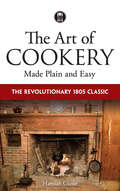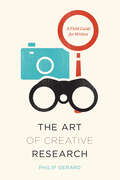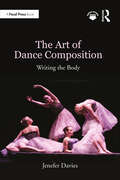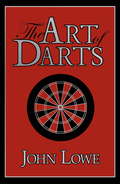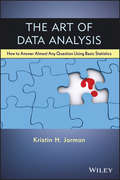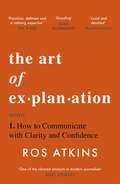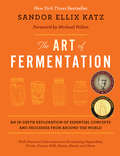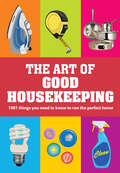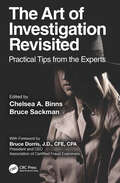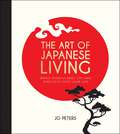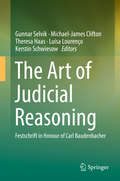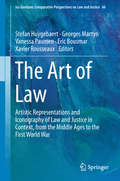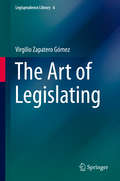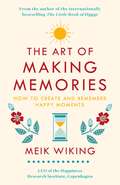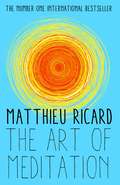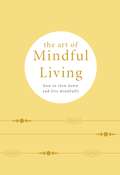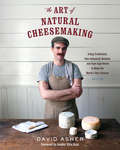- Table View
- List View
The Art of Cookery Made Plain and Easy: The Revolutionary 1805 Classic
by Hannah Glasse"A very interesting glimpse at everyday cooking in the daily life of 18th–19th century England, with many helpful tips, tricks, and recipes (for the day). The language is enjoyable and the information contained is substantial." — Jefferson-Madison Regional Library SystemRevised and republished many times since its 1747 debut, this cookbook was a bestseller in England and the United States for more than 100 years. George Washington and Thomas Jefferson owned copies, and Benjamin Franklin even translated some of its recipes into French in hopes of attaining a taste of home while abroad. Author Hannah Glasse dismisses French cookery, the leading cuisine of her day, as inefficient for servants and middle- to lower-class cooks, citing its fussiness, expense, and waste. Instead, Mrs. Glasse focuses on standard Anglo-American fare, from soups and gravies to cakes and jellies, all simple dishes, prepared in a straightforward manner. In addition to practical advice on meat selection, carving, and basic cooking skills, this historically fascinating document offers tips on preparing food for the ill, cooking and food storage on ships, and making soaps and scents for the home. Historians, cooks, and all lovers of gastronomy will appreciate this glimpse into the kitchens of a bygone era.
The Art of Creative Research: A Field Guide for Writers (Chicago Guides to Writing, Editing, and Publishing)
by Philip GerardAll writers conduct research. For some this means poring over records and combing, archives but for many creative writers research happens in the everyday world—when they scribble an observation on the subway, when they travel to get the feel for a city, or when they strike up a conversation with an interesting stranger. The Art of Creative Research helps writers take this natural inclination to explore and observe and turn it into a workable—and enjoyable—research plan. It shows that research shouldn’t be seen as a dry, plodding aspect of writing. Instead, it’s an art that all writers can master, one that unearths surprises and fuels imagination. This lends authenticity to fiction and poetry as well as nonfiction. Philip Gerard distills the process into fundamental questions: How do you conduct research? And what can you do with the information you gather? He covers both in-person research and work in archives and illustrates how the different types of research can be incorporated into stories, poems, and essays using examples from a wide range of writers in addition to those from his own projects. Throughout, Gerard brings knowledge from his seasoned background into play, drawing on his experiences as a reporter and a writer of both fiction and nonfiction. His enthusiasm for adventure is infectious and will inspire writers to step away from the keyboard and into the world. “Research can take you to that golden intersection where the personal meets the public, the private crosses the universal, where the best literature lives,” Gerard writes. With his masterly guidance, anyone can become an expert in artful investigation.
The Art of Creative Research: A Field Guide for Writers (Chicago Guides to Writing, Editing, and Publishing)
by Philip GerardAll writers conduct research. For some this means poring over records and combing, archives but for many creative writers research happens in the everyday world—when they scribble an observation on the subway, when they travel to get the feel for a city, or when they strike up a conversation with an interesting stranger. The Art of Creative Research helps writers take this natural inclination to explore and observe and turn it into a workable—and enjoyable—research plan. It shows that research shouldn’t be seen as a dry, plodding aspect of writing. Instead, it’s an art that all writers can master, one that unearths surprises and fuels imagination. This lends authenticity to fiction and poetry as well as nonfiction. Philip Gerard distills the process into fundamental questions: How do you conduct research? And what can you do with the information you gather? He covers both in-person research and work in archives and illustrates how the different types of research can be incorporated into stories, poems, and essays using examples from a wide range of writers in addition to those from his own projects. Throughout, Gerard brings knowledge from his seasoned background into play, drawing on his experiences as a reporter and a writer of both fiction and nonfiction. His enthusiasm for adventure is infectious and will inspire writers to step away from the keyboard and into the world. “Research can take you to that golden intersection where the personal meets the public, the private crosses the universal, where the best literature lives,” Gerard writes. With his masterly guidance, anyone can become an expert in artful investigation.
The Art of Creative Research: A Field Guide for Writers (Chicago Guides to Writing, Editing, and Publishing)
by Philip GerardAll writers conduct research. For some this means poring over records and combing, archives but for many creative writers research happens in the everyday world—when they scribble an observation on the subway, when they travel to get the feel for a city, or when they strike up a conversation with an interesting stranger. The Art of Creative Research helps writers take this natural inclination to explore and observe and turn it into a workable—and enjoyable—research plan. It shows that research shouldn’t be seen as a dry, plodding aspect of writing. Instead, it’s an art that all writers can master, one that unearths surprises and fuels imagination. This lends authenticity to fiction and poetry as well as nonfiction. Philip Gerard distills the process into fundamental questions: How do you conduct research? And what can you do with the information you gather? He covers both in-person research and work in archives and illustrates how the different types of research can be incorporated into stories, poems, and essays using examples from a wide range of writers in addition to those from his own projects. Throughout, Gerard brings knowledge from his seasoned background into play, drawing on his experiences as a reporter and a writer of both fiction and nonfiction. His enthusiasm for adventure is infectious and will inspire writers to step away from the keyboard and into the world. “Research can take you to that golden intersection where the personal meets the public, the private crosses the universal, where the best literature lives,” Gerard writes. With his masterly guidance, anyone can become an expert in artful investigation.
The Art of Creative Research: A Field Guide for Writers (Chicago Guides to Writing, Editing, and Publishing)
by Philip GerardAll writers conduct research. For some this means poring over records and combing, archives but for many creative writers research happens in the everyday world—when they scribble an observation on the subway, when they travel to get the feel for a city, or when they strike up a conversation with an interesting stranger. The Art of Creative Research helps writers take this natural inclination to explore and observe and turn it into a workable—and enjoyable—research plan. It shows that research shouldn’t be seen as a dry, plodding aspect of writing. Instead, it’s an art that all writers can master, one that unearths surprises and fuels imagination. This lends authenticity to fiction and poetry as well as nonfiction. Philip Gerard distills the process into fundamental questions: How do you conduct research? And what can you do with the information you gather? He covers both in-person research and work in archives and illustrates how the different types of research can be incorporated into stories, poems, and essays using examples from a wide range of writers in addition to those from his own projects. Throughout, Gerard brings knowledge from his seasoned background into play, drawing on his experiences as a reporter and a writer of both fiction and nonfiction. His enthusiasm for adventure is infectious and will inspire writers to step away from the keyboard and into the world. “Research can take you to that golden intersection where the personal meets the public, the private crosses the universal, where the best literature lives,” Gerard writes. With his masterly guidance, anyone can become an expert in artful investigation.
The Art of Creative Research: A Field Guide for Writers (Chicago Guides to Writing, Editing, and Publishing)
by Philip GerardAll writers conduct research. For some this means poring over records and combing, archives but for many creative writers research happens in the everyday world—when they scribble an observation on the subway, when they travel to get the feel for a city, or when they strike up a conversation with an interesting stranger. The Art of Creative Research helps writers take this natural inclination to explore and observe and turn it into a workable—and enjoyable—research plan. It shows that research shouldn’t be seen as a dry, plodding aspect of writing. Instead, it’s an art that all writers can master, one that unearths surprises and fuels imagination. This lends authenticity to fiction and poetry as well as nonfiction. Philip Gerard distills the process into fundamental questions: How do you conduct research? And what can you do with the information you gather? He covers both in-person research and work in archives and illustrates how the different types of research can be incorporated into stories, poems, and essays using examples from a wide range of writers in addition to those from his own projects. Throughout, Gerard brings knowledge from his seasoned background into play, drawing on his experiences as a reporter and a writer of both fiction and nonfiction. His enthusiasm for adventure is infectious and will inspire writers to step away from the keyboard and into the world. “Research can take you to that golden intersection where the personal meets the public, the private crosses the universal, where the best literature lives,” Gerard writes. With his masterly guidance, anyone can become an expert in artful investigation.
The Art of Creative Research: A Field Guide for Writers (Chicago Guides to Writing, Editing, and Publishing)
by Philip GerardAll writers conduct research. For some this means poring over records and combing, archives but for many creative writers research happens in the everyday world—when they scribble an observation on the subway, when they travel to get the feel for a city, or when they strike up a conversation with an interesting stranger. The Art of Creative Research helps writers take this natural inclination to explore and observe and turn it into a workable—and enjoyable—research plan. It shows that research shouldn’t be seen as a dry, plodding aspect of writing. Instead, it’s an art that all writers can master, one that unearths surprises and fuels imagination. This lends authenticity to fiction and poetry as well as nonfiction. Philip Gerard distills the process into fundamental questions: How do you conduct research? And what can you do with the information you gather? He covers both in-person research and work in archives and illustrates how the different types of research can be incorporated into stories, poems, and essays using examples from a wide range of writers in addition to those from his own projects. Throughout, Gerard brings knowledge from his seasoned background into play, drawing on his experiences as a reporter and a writer of both fiction and nonfiction. His enthusiasm for adventure is infectious and will inspire writers to step away from the keyboard and into the world. “Research can take you to that golden intersection where the personal meets the public, the private crosses the universal, where the best literature lives,” Gerard writes. With his masterly guidance, anyone can become an expert in artful investigation.
The Art of Dance Composition: Writing the Body
by Jenefer DaviesThe Art of Dance Composition: Writing the Body is an introduction to modern dance composition, providing clear and structured approaches to designing and defining movement that demystify the creative process.The book introduces the concepts of creating authentic movement, processes for gathering and ordering compositional elements, and the ways in which theme, story, and design relate to bodies moving through space. It approaches the practice of composition from many avenues, including the use of digital tools such as video and video editing software, digital mapping, and motion capture, and through improvisation, sourced gestures, and inspiration from visual art, found objects, and chance methodology. Flowcharts that organize and provide a framework for making dance are included, equipping readers with a clear roadmap for creating their own work.Filled with practical advice, this book is suitable for all aspiring choreographers.The Art of Dance Composition: Writing the Body includes access to performance videos that demonstrate the concepts illustrated in the book. To access the videos, visit www.daviesanddancers.com/links-to-writing-the-body.
The Art of Dance Composition: Writing the Body
by Jenefer DaviesThe Art of Dance Composition: Writing the Body is an introduction to modern dance composition, providing clear and structured approaches to designing and defining movement that demystify the creative process.The book introduces the concepts of creating authentic movement, processes for gathering and ordering compositional elements, and the ways in which theme, story, and design relate to bodies moving through space. It approaches the practice of composition from many avenues, including the use of digital tools such as video and video editing software, digital mapping, and motion capture, and through improvisation, sourced gestures, and inspiration from visual art, found objects, and chance methodology. Flowcharts that organize and provide a framework for making dance are included, equipping readers with a clear roadmap for creating their own work.Filled with practical advice, this book is suitable for all aspiring choreographers.The Art of Dance Composition: Writing the Body includes access to performance videos that demonstrate the concepts illustrated in the book. To access the videos, visit www.daviesanddancers.com/links-to-writing-the-body.
The Art of Darts
by John LoweCan't hit the doubles? Got a bad case of dartitis? Want to stick it in the bull every time? You've come to the right place. THE ART OF DARTS is three-time World Champion John Lowe's darts master class that caters for every level of player, from the obsessed amateur to the fledgling professional, and reveals the secrets of his three decades experience at the pinnacle of the sport. Every conceivable aspect of the game is covered, from choosing the right grip, darts and practice routines to suit you, constructing out shots, perfecting your stance at the oche to tips on how to cope with the pressure of a sold out, noisy arena in your first professional match. Whether you want to improve your game wholesale or simply fine tune some misbehaving aspects, THE ART OF DARTS is essential for every darts player, fan or enthusiast and is well set to becoming the classic darts text.
The Art of Data Analysis: How to Answer Almost Any Question Using Basic Statistics
by Kristin H. JarmanA friendly and accessible approach to applying statistics in the real world With an emphasis on critical thinking, The Art of Data Analysis: How to Answer Almost Any Question Using Basic Statistics presents fun and unique examples, guides readers through the entire data collection and analysis process, and introduces basic statistical concepts along the way. Leaving proofs and complicated mathematics behind, the author portrays the more engaging side of statistics and emphasizes its role as a problem-solving tool. In addition, light-hearted case studies illustrate the application of statistics to real data analyses, highlighting the strengths and weaknesses of commonly used techniques. Written for the growing academic and industrial population that uses statistics in everyday life, The Art of Data Analysis: How to Answer Almost Any Question Using Basic Statistics highlights important issues that often arise when collecting and sifting through data. Featured concepts include: • Descriptive statistics • Analysis of variance • Probability and sample distributions • Confidence intervals • Hypothesis tests • Regression • Statistical correlation • Data collection • Statistical analysis with graphs Fun and inviting from beginning to end, The Art of Data Analysis is an ideal book for students as well as managers and researchers in industry, medicine, or government who face statistical questions and are in need of an intuitive understanding of basic statistical reasoning.
The Art of Data Analysis: How to Answer Almost Any Question Using Basic Statistics
by Kristin H. JarmanA friendly and accessible approach to applying statistics in the real world With an emphasis on critical thinking, The Art of Data Analysis: How to Answer Almost Any Question Using Basic Statistics presents fun and unique examples, guides readers through the entire data collection and analysis process, and introduces basic statistical concepts along the way. Leaving proofs and complicated mathematics behind, the author portrays the more engaging side of statistics and emphasizes its role as a problem-solving tool. In addition, light-hearted case studies illustrate the application of statistics to real data analyses, highlighting the strengths and weaknesses of commonly used techniques. Written for the growing academic and industrial population that uses statistics in everyday life, The Art of Data Analysis: How to Answer Almost Any Question Using Basic Statistics highlights important issues that often arise when collecting and sifting through data. Featured concepts include: • Descriptive statistics • Analysis of variance • Probability and sample distributions • Confidence intervals • Hypothesis tests • Regression • Statistical correlation • Data collection • Statistical analysis with graphs Fun and inviting from beginning to end, The Art of Data Analysis is an ideal book for students as well as managers and researchers in industry, medicine, or government who face statistical questions and are in need of an intuitive understanding of basic statistical reasoning.
The Art of Explanation: How to Communicate with Clarity and Confidence
by Ros Atkins'For all those who want their audiences to listen and understand' JEREMY BOWEN | 'Precision, deftness and a calming expertise' THE TIMES Do you worry about holding people's attention during presentations?Are you unsure where to start when faced with writing an essay or report?Are you preparing for an interview and wondering how to get all your points across?Explanation - identifying and communicating what we want to say - is an art. And the BBC presenter and journalist Ros Atkins, creator of the viral 'Ros Atkins on...' explainer videos, is something of a master of the form. In this book, Ros shares the secrets he has learned from years of working in high-pressure newsrooms, identifying the ten elements of a good explanation and the seven steps you need to take to express yourself with clarity and impact.Whether at work, school, university or home, we all benefit from being able to articulate ourselves clearly. Filled with practical examples, The Art of Explanation is a must-read for anyone who wants to sharpen their communication skills.
The Art of Fermentation: An In-Depth Exploration of Essential Concepts and Processes from around the World
by Sandor Ellix Katz Michael PollanWinner of the 2013 James Beard Foundation Book Award for Reference and Scholarship, and a New York Times bestseller, The Art of Fermentation is the most comprehensive guide to do-it-yourself home fermentation ever published. Sandor Katz presents the concepts and processes behind fermentation in ways that are simple enough to guide a reader through their first experience making sauerkraut or yogurt, and in-depth enough to provide greater understanding and insight for experienced practitioners. While Katz expertly contextualizes fermentation in terms of biological and cultural evolution, health and nutrition, and even economics, this is primarily a compendium of practical information—how the processes work; parameters for safety; techniques for effective preservation; troubleshooting; and more. With two-color illustrations and extended resources, this book provides essential wisdom for cooks, homesteaders, farmers, gleaners, foragers, and food lovers of any kind who want to develop a deeper understanding and appreciation for arguably the oldest form of food preservation, and part of the roots of culture itself. Readers will find detailed information on fermenting vegetables; sugars into alcohol (meads, wines, and ciders); sour tonic beverages; milk; grains and starchy tubers; beers (and other grain-based alcoholic beverages); beans; seeds; nuts; fish; meat; and eggs, as well as growing mold cultures, using fermentation in agriculture, art, and energy production, and considerations for commercial enterprises. Sandor Katz has introduced what will undoubtedly remain a classic in food literature, and is the first—and only—of its kind.
The Art of Good Housekeeping
by Good Housekeeping InstituteAll you need to run a modern home Hundreds of expert time-and-money-saving ideas A must-have for every household
The Art of Investigation Revisited: Practical Tips from the Experts
by Chelsea A. Binns Bruce SackmanThe Art of Investigation Revisited: Practical Tips from the Experts examines the qual- ities required to be a professional, thorough, and effective investigator and is a follow up to the authors’ highly touted book, The Art of Investigation (2019). This book features a wholly new line-up of investigators, experienced professionals in the field, who delve into the "soft skills" that make an investigator effective. Each chapter examines a specific quality required to be a professional, thorough, and—most importantly—successful in this challenging discipline. The editors, and contributing authors, are all top in their field and bring a wealth of real-world knowledge and experience to the subject. While several publications exist on the procedures and steps of an investigation, few books cover the creative and intuitive skills required. Such traits are necessary to continually question in the face of investigative roadblocks, unique qualities endemic to an inquisitive mind that can be trained to improve an investigator’s professional skill set. Each chapter discusses the applicability of the traits and requirements to the contributor’s own work and experience as an investigator. In doing so, the contributors will provide valuable stories from their personal experience, which demonstrates their use or a given trait and its importance in the course of their investigative work and career. The case examples included throughout are engaging and, as is often the case, surprising. An investigator must keep an open mind above all else and this book seeks to "lift the veil" on the inner workings of an investigation and the thought pro- cess and inner monologue of an investigator as part of that process. The book is a welcome addition to any investigator’s toolkit and is also of interest to students in criminal justice, security and Homeland Security programs, security consultants, corporate and private security professionals, and the legal community. Chelsea A. Binns is an Assistant Professor and Director of the Center for Private Safety and Security at John Jay College of Criminal Justice. She is also the Director of John Jay’s Center for Private Security and Safety. Chelsea has a PhD in Criminal Justice from the CUNY Graduate Center and is a licensed private investigator and a certified fraud examiner. Prior to working at John Jay, she was an investigator for the City and State of New York and in the financial industry. Bruce Sackman served as the Special Agent in Charge, U.S. Department of Veteran Affairs (VA), Office of Inspector General, Criminal Investigations Division, Northeast Field Office. He is also a recently retired self-employed licensed private investigator in New York City specializing in healthcare related matters. He is a frequent lecturer on the topic of medical serial killers having spoken throughout the United States, Great Britain, United Arab Emirates, and Sweden.
The Art of Investigation Revisited: Practical Tips from the Experts
by Chelsea A Binns Bruce SackmanThe Art of Investigation Revisited: Practical Tips from the Experts examines the qual- ities required to be a professional, thorough, and effective investigator and is a follow up to the authors’ highly touted book, The Art of Investigation (2019). This book features a wholly new line-up of investigators, experienced professionals in the field, who delve into the "soft skills" that make an investigator effective. Each chapter examines a specific quality required to be a professional, thorough, and—most importantly—successful in this challenging discipline. The editors, and contributing authors, are all top in their field and bring a wealth of real-world knowledge and experience to the subject. While several publications exist on the procedures and steps of an investigation, few books cover the creative and intuitive skills required. Such traits are necessary to continually question in the face of investigative roadblocks, unique qualities endemic to an inquisitive mind that can be trained to improve an investigator’s professional skill set. Each chapter discusses the applicability of the traits and requirements to the contributor’s own work and experience as an investigator. In doing so, the contributors will provide valuable stories from their personal experience, which demonstrates their use or a given trait and its importance in the course of their investigative work and career. The case examples included throughout are engaging and, as is often the case, surprising. An investigator must keep an open mind above all else and this book seeks to "lift the veil" on the inner workings of an investigation and the thought pro- cess and inner monologue of an investigator as part of that process. The book is a welcome addition to any investigator’s toolkit and is also of interest to students in criminal justice, security and Homeland Security programs, security consultants, corporate and private security professionals, and the legal community. Chelsea A. Binns is an Assistant Professor and Director of the Center for Private Safety and Security at John Jay College of Criminal Justice. She is also the Director of John Jay’s Center for Private Security and Safety. Chelsea has a PhD in Criminal Justice from the CUNY Graduate Center and is a licensed private investigator and a certified fraud examiner. Prior to working at John Jay, she was an investigator for the City and State of New York and in the financial industry. Bruce Sackman served as the Special Agent in Charge, U.S. Department of Veteran Affairs (VA), Office of Inspector General, Criminal Investigations Division, Northeast Field Office. He is also a recently retired self-employed licensed private investigator in New York City specializing in healthcare related matters. He is a frequent lecturer on the topic of medical serial killers having spoken throughout the United States, Great Britain, United Arab Emirates, and Sweden.
The Art of Japanese Living: Bring Mindfulness, Joy and Simplicity Into Your Life
by Jo PetersLearn the Japanese secrets to finding calm, contentment and happinessWith its roots in Buddhist thinking, Japanese culture is known for its sincere and mindful approach to life. From ikigai (finding your purpose) to ikebana (the art of flower arranging), Japanese ideas offer the wider world the promise of peacefulness and inspiration.Discover these calming insights and more inside this beautiful volume. Including tips on mindfulness, finding contentment, and doing more with less, this book will be your guide to the land of the rising sun, and help you to live a rich, joyful and thoughtful life.
The Art of Judicial Reasoning: Festschrift in Honour of Carl Baudenbacher
by Gunnar Selvik Michael-James Clifton Theresa Haas Luísa Lourenço Kerstin SchwiesowThis book, formed as a series of essays in honour of Professor Carl Baudenbacher, addresses the very art of judicial reasoning, and features contributions from many of the foremost current or former national, supranational, or international judges. This unique volume is intended first and foremost for legal scholars, but its approachable style makes it readily accessible for students and for those with a general interest in the application of the law and justice in today’s multi-layered world. The collection of essays is rather more philosophical and reflective as opposed to doctrinal. Each contribution focuses on the nature and operation of justice, the independence of the judiciary, and on judicial style primarily from the perspective of the judges themselves. The book provides perspectives on what it means to be accountable and independent as a judge, the role of language and languages in the quest for justice, while other contributions acquaint readers with the some of the structures of courts themselves, or indeed question for whom judgments are written. Each chapter has been written by a presiding judge, or head of an institution and the book is divided into three parts: - Part I Art and Method- Part II Justice and the Judiciary- Part III Reasoning and Language(s)
The Art of Law: Artistic Representations and Iconography of Law and Justice in Context, from the Middle Ages to the First World War (Ius Gentium: Comparative Perspectives on Law and Justice #66)
by Stefan Huygebaert Georges Martyn Vanessa Paumen Eric Bousmar Xavier RousseauxThe contributions to this volume were written by historians, legal historians and art historians, each using his or her own methods and sources, but all concentrating on topics from the broad subject of historical legal iconography. How have the concepts of law and justice been represented in (public) art from the Late Middle Ages onwards? Justices and rulers had their courtrooms, but also churches, decorated with inspiring images. At first, the religious influence was enormous, but starting with the Early Modern Era, new symbols and allegories began appearing. Throughout history, art has been used to legitimise the act of judging, but artists have also satirised the law and the lawyers; architects and artisans have engaged in juridical and judicial projects and, in some criminal cases, convicts have even been sentenced to produce works of art. The book illustrates and contextualises the various interactions between law and justice on the one hand, and their artistic representations in paintings, statues, drawings, tapestries, prints and books on the other.
The Art of Legislating (Legisprudence Library #6)
by Virgilio Zapatero GómezAny contemporary state presents itself as committed to the “rule of law”, and this notion is perhaps the most powerful political ideal within the current global discourse on legal and political institutions. Despite being a contested concept, the rule of law is generally recognised as meaning that government is bound in all its actions by fixed and public rules, and that these rules respect certain formal requirements and are enforced by an independent judiciary. This book focuses on formal legality and the question of how to achieve good laws—a topic that was famously addressed by the 18th century enlightened thinkers, but also by prominent legal scholars of our time. Historically, the canon of “good legislation” demanded generality, publicity and accessibility, and comprehensibility of laws; non-retroactivity; consistency; the possibility of complying with legal obligations and prohibitions; stability; and congruency between enacted laws and their application. All these are valuable ideals that should not be abandoned in today’s legal systems, particularly in view of the silent revolution that is transforming our legality-based “states of law” into jurisdictional states. Such ideals are still worth pursuing for those who believe in representative democracy, in the rule of law and in the dignity of legislation. The idea for the book stemmed from the author’s parliamentary and governmental experience; he was responsible for the Government of Spain’s legislative co-ordination from 1982 to 1993, which were years of intensive legislative production. The more than five hundred laws (and thousands of decrees) elaborated in this period profoundly changed all sectors of the legal order inherited from Franco’s dictatorship, and laid the foundations of a new social and democratic system. For an academic, this was an exciting experience, which offered a unique opportunity to put the theory of legislation to the test. Reflecting and elaborating on this experience, the book not only increases scholarly awareness of how laws are made, but above all, improves the quality of legislation and as a result the rule of law.
The Art of Making Memories: How to Create and Remember Happy Moments (The\happiness Institute Ser.)
by Meik Wiking"Happy memories are essential to our mental health. They strengthen our identity, sense of purpose and relationships. Meik's new book will teach you how to create and remember happy moments and will change how you think about happy memories." Dr Rangan Chatterjee, Number One bestselling author of The 4 Pillar Plan and BBC Breakfast GP The third book from the CEO of the Happiness Research Institute and internationally bestselling author of The Little Book of Hygge, Meik Wiking.Why is it that a piece of music, a smell, a taste can take us back to something we had forgotten? How is it that we remember our first kiss in detail, but barely remember anything of a fortnight's holiday from five years ago? Memories are the cornerstones of our identity, shaping who we are, how we act, and how we feel. But how do we make and keep the memories that bring us lasting joy?Happiness expert Meik Wiking has the answers. In The Art of Making Memories he brings together his extensive research drawn from the world's biggest study on happy memories (which involved 1000 people from 75 countries), conducted at the Happiness Research Institute, along with data and diaries, interviews, global surveys and studies, and real-life behavioural science and happiness experiments, to explain the nuances of nostalgia, the different ways we form memories around our experiences, and how we can become better at recalling them.Written in Meik's warm and funny trademark style, filled with infographics, illustrations, and photographs, and featuring "Happy Memory Tips", The Art of Making Memoriesis a life-affirming read which show you it's easier than you think to make your life unforgettable.**Pre-order The Art of Making Memories in the UK and receive a Hygge Manifesto print from Meik's first book. Visit www.penguin.co.uk/makingmemories for details on how to claim your print**
The Art of Meditation
by Matthieu RicardA Sunday Times bestseller, this new paperback is an elegant and inspiring short guide to the art of meditation: another instant classic from the bestselling author of Happiness.Wherever he goes, Buddhist monk Matthieu Ricard is asked to explain what meditation is, how it is done and what it can achieve. In this authoritative and inspiring book, he sets out to answer these questions. Matthieu Ricard shows that practising meditation can change our understanding of ourselves and the world around us. He talks us through its theory, spirituality and practical aspects of deep contemplation and illustrates each stage of his teaching with examples. Through his experience as a monk, his close reading of sacred texts and his deep knowledge of the Buddhist masters, Matthieu Ricard reveals the significant benefits that meditation - based on selfless love and compassion - can bring to each of us.
The Art of Mindful Living: How to Slow Down and Live Mindfully
by PyramidMindful is about fully appreciating life's little pleasures and the most precious of moments that, all too often, pass by unnoticed when the mind is distracted. Though it seems like a paradox, slowing down to focus on one thing at a time and resisting the urge to multi-task can actually make us more productive by allowing us to deliberately concentrate our energy on our most important tasks. Likewise, mindful living also helps us be more aware of our thought patterns so that we can cultivate inner peace and appreciate the beauty in our day to day lives.This little collection of tips, inspirational quotes and reflections will help you find new strategies to:- stay focused and resist the urge to multitask,- take a few minutes to meditate and recentre yourself,- create a calming environment,- appreciate the beauty around you,- be more patient,- and manage your emotions to cultivate inner peace.This book will show you just how impactful it can be to take a few short moments to calm your mind and will ultimately help live a more peaceful and focused life.
The Art of Natural Cheesemaking: Using Traditional, Non-Industrial Methods and Raw Ingredients to Make the World's Best Cheeses
by David Asher Sandor Ellix KatzIncluding more than 35 step-by-step recipes from the Black Sheep School of Cheesemaking Most DIY cheesemaking books are hard to follow, complicated, and confusing, and call for the use of packaged freeze-dried cultures, chemical additives, and expensive cheesemaking equipment. For though bread baking has its sourdough, brewing its lambic ales, and pickling its wild fermentation, standard Western cheesemaking practice today is decidedly unnatural. In The Art of Natural Cheesemaking, David Asher practices and preaches a traditional, but increasingly countercultural, way of making cheese—one that is natural and intuitive, grounded in ecological principles and biological science. This book encourages home and small-scale commercial cheesemakers to take a different approach by showing them: • How to source good milk, including raw milk; • How to keep their own bacterial starter cultures and fungal ripening cultures; • How make their own rennet—and how to make good cheese without it; • How to avoid the use of plastic equipment and chemical additives; and • How to use appropriate technologies. Introductory chapters explore and explain the basic elements of cheese: milk, cultures, rennet, salt, tools, and the cheese cave. The fourteen chapters that follow each examine a particular class of cheese, from kefir and paneer to washed-rind and alpine styles, offering specific recipes and handling advice. The techniques presented are direct and thorough, fully illustrated with hand-drawn diagrams and triptych photos that show the transformation of cheeses in a comparative and dynamic fashion. The Art of Natural Cheesemaking is the first cheesemaking book to take a political stance against Big Dairy and to criticize both standard industrial and artisanal cheesemaking practices. It promotes the use of ethical animal rennet and protests the use of laboratory-grown freeze-dried cultures. It also explores how GMO technology is creeping into our cheese and the steps we can take to stop it. This book sounds a clarion call to cheesemakers to adopt more natural, sustainable practices. It may well change the way we look at cheese, and how we make it ourselves.
